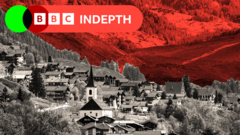Are Melting Glaciers About to Destroy European Villages? Is the Cost of Protection Justified?

Rebuilding Hope: The Resilience of Blatten, Switzerland
In the picturesque Loetschental valley of Switzerland, the small village of Blatten has become a symbol of resilience and community spirit in the wake of a devastating natural disaster. Just two months ago, the village, once home to 300 residents, was obliterated by a catastrophic collapse of a mountain and glacier, displacing families and erasing their cherished history. Today, as recovery efforts are underway, the spirit of the villagers shines through as they confront the daunting task of rebuilding their lives and homes.
Matthias Bellwald, the mayor of a neighboring village, now oversees the extensive clean-up operation from a temporary office in Wiler. “The situation is dire but we are determined to rebuild Blatten,” he states. With a projected timeline suggesting that the site could be cleared by 2028 and new houses ready by 2029, there is hope for the future. However, this monumental task comes at a staggering cost, estimated to reach hundreds of millions of dollars, or about $1 million per resident.
The Emotional Toll of Displacement
The emotional ramifications of this disaster have been profound. Lukas Kalbermatten, who lost his family’s hotel that had stood for three generations, describes the loss of his village with deep sorrow. “The feeling of the village, all the small alleys, the church, the memories of my childhood—they're all gone,” he laments. Today, he resides in borrowed accommodation, grappling with the uncertainty of the future.
The evacuation of Blatten was a precautionary measure, initiated after geologists warned of the increasing instability of the mountain. Yet, the residents had not anticipated the scale of the disaster that would soon befall them. Fernando Lehner, a retired businessman, recalls the moment the mountain gave way. “We knew there would be a landslide that day, but it was just unbelievable. The earth shook,” he reflects, echoing the sentiments of many who lived through that harrowing experience.
Climate Change and Its Impact on Alpine Communities
As the residents of Blatten begin to rebuild, discussions surrounding climate change and its implications for the future of alpine villages are growing more urgent. Climate scientists warn that the glaciers and permafrost—critical stabilizing factors for the mountains—are thawing due to rising global temperatures, which increases the likelihood of landslides. Matthias Huss, a glaciologist, argues that the thawing of permafrost contributed directly to the collapse that devastated Blatten. “Climate change was involved at every angle,” he asserts.
While the disaster has sparked a debate on the viability of rebuilding, it has also prompted broader questions about the sustainability of living in mountainous regions. Switzerland allocates nearly $500 million yearly on protective structures, yet experts estimate that true protection against natural hazards could cost up to six times that amount. This raises a critical question: is it feasible to continue investing in the protection of every alpine village, or should some communities consider relocation as a realistic option?
The Cultural Significance of Alpine Villages
The Alps are not just geographical features; they are deeply woven into the fabric of Swiss identity. Each valley, including the Loetschental, boasts its unique culture and traditions. The loss of Blatten represents more than just the physical destruction of homes—it threatens to erase a way of life that has existed for centuries. The word “heimat,” which signifies a deep connection to one’s homeland, resonates strongly with many Swiss citizens. For Kalbermatten and his family, their heimat is not merely a place but a repository of memories, traditions, and cultural heritage.
The fear of losing not only their homes but also the rich cultural tapestry that defines their identity is palpable among the residents. The Tschäggättä, traditional wooden masks unique to the Loetschental valley, symbolize this cultural richness. As local traditions risk fading into obscurity, many Swiss are left pondering the future of their alpine heritage amidst the looming threat of climate change.
Economic Considerations and Community Sentiment
The economic implications of rebuilding Blatten are significant. While the federal government and local cantons have pledged financial support, the question remains whether the investment is justified. An editorial in the influential Neue Zürcher Zeitung highlighted the dilemma, suggesting that increasing climate-related disasters could erode public willingness to fund the preservation of mountain communities. The sentiment resonates with many Swiss, who find themselves caught between the desire to protect their cultural heritage and the pragmatic considerations of financial viability.
In the aftermath of the disaster, sympathy for the victims has poured in from across the nation. Yet, as discussions deepen about the future of alpine villages, some are advocating for a more sustainable approach that may involve relocation from high-risk areas. This perspective, while controversial, stems from a growing recognition that climate change is not a distant threat but a present reality that necessitates proactive measures.
Lessons from the Past: Historical Context of Swiss Alpine Villages
Switzerland's history is marked by its rural roots, often characterized by struggle and resilience. The 19th-century famine led to significant emigration, and many Swiss people maintain strong ties to their mountainous heritage. This connection is evident in the pride that residents take in their alpine traditions, which includes not only cultural practices but also a profound appreciation for the natural beauty of their landscape.
However, as climate change continues to escalate, the question arises: how can the Swiss balance their historical connection to the land with the realities of modern environmental challenges? Boris Previsic, director of the University of Lucerne's Institute for the Culture of the Alps, suggests that the Swiss have historically believed they could master the alpine environment through infrastructure. Yet, he warns that this confidence may be misplaced, as climate change reshapes the geological landscape. “The human-induced geology is too strong compared to human beings,” he posits.
Moving Forward: A Collective Responsibility
The recovery efforts in Blatten are a testament to the collective spirit of its residents and the broader Swiss community. Even amidst uncertainty, there is a palpable sense of determination to rebuild and restore the village. The daily hustle in Wiler, where teams of engineers and clean-up crews work tirelessly, embodies this resolve. As they navigate the challenges ahead, the residents of Blatten are not merely restoring their homes; they are reaffirming their identity and commitment to their community.
Ultimately, the future of Blatten and similar alpine villages lies in the balance of tradition, sustainability, and adaptability. As the villagers continue to grapple with the aftermath of the disaster, they are reminded that while the mountains are both beautiful and formidable, it is their shared history and culture that will ultimately guide them through the rebuilding process.
FAQs
What caused the disaster in Blatten?
The disaster in Blatten was caused by a catastrophic collapse of a mountain and glacier, resulting in the obliteration of the village.
How are the residents coping with the aftermath?
Residents are currently living in temporary accommodations and participating in recovery efforts as they work towards rebuilding their village.
What role does climate change play in the instability of alpine villages?
Climate change is contributing to the thawing of glaciers and permafrost, which are critical stabilizing factors for mountains, increasing the likelihood of landslides.
Will Blatten be rebuilt?
Yes, plans are in place to clear the site by 2028, with new houses anticipated to be ready by 2029, although the costs will be substantial.
What is the cultural significance of Blatten to its residents?
Blatten represents not only a home but a deep connection to Swiss heritage, history, and community, embodying traditions that have been passed down through generations.
As the villagers of Blatten begin to rebuild, they face an uncertain future. Will they be able to restore not only their homes but also their cultural identity in the face of climate change? #Switzerland #ClimateChange #CulturalHeritage
```Published: 2025-08-02 23:18:28 | Category: world



